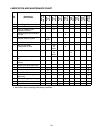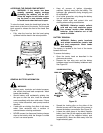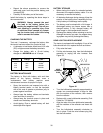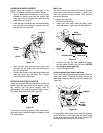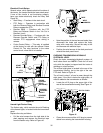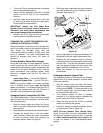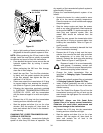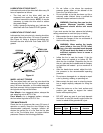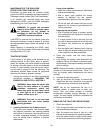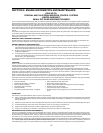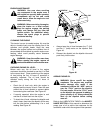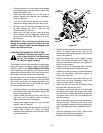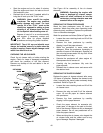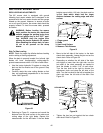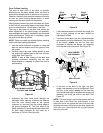
36
MAINTENANCE OF THE ROLLOVER
PROTECTIVE STRUCTURE (ROPS)
Periodically (at least every six months) visually
inspect the ROPS for damage and loose fasteners.
If damage is noted, contact your Cub Cadet dealer.
If an accident has occurred which may have
damaged the ROPS, have the ROPS thoroughly
inspected by your Cub Cadet dealer.
WARNING: To ensure the structural
integrity of the ROPS to provide opera-
tor protection, do not attempt to
straighten or weld the ROPS. A dam-
aged ROPS should be replaced.
If the ROPS is removed for any reason, make sure
the proper hardware is used to reinstall it, and that
the recommended torque values are applied to the
fasteners.
When replacing or reinstalling the ROPS, apply
Loctite
®
242 to the threads of the bolts and torque
the bolts to 60 to 70 ft. lbs.
TRACTOR STORAGE
If your tractor is not going to be operated for an
extended period of time (thirty days to approxi-
mately six months), the tractor should be prepared
for storage. Store the tractor in a dry and protected
location. If stored outside, cover the tractor (includ-
ing the tires) to protect it from the elements. The
procedures outlined below should be performed
whenever the tractor is placed in storage.
1. Change the engine oil and filter following the
instructions provided in CHANGING THE
ENGINE OIL AND FILTER in SECTION 5.
WARNING: Never store the tractor with
fuel in the tank indoors or in poorly
ventilated enclosures, where fuel
fumes may reach an open flame, spark
or pilot light as on a furnace, water
heater, clothes dryer, etc.
WARNING: Fuel left in the fuel tank
deteriorates and will cause serious
starting problems.
2. If storing the tractor for 30 days or more:
To prevent gum deposits from forming inside
the engine’s carburetor and causing possible
malfunction of the engine, the fuel system must
be either completely emptied, or the gasoline
must be treated with a stabilizer to prevent
deterioration.
Using a fuel stabilizer:
• Read the product manufacturer’s instructions
and recommendations.
• Add to clean, fresh gasoline the correct
amount of stabilizer for the capacity
(approximately 6 gallons) of the fuel system.
• Fill the fuel tank with treated fuel and run the
engine for 2-3 minutes to get stabilized fuel
into the carburetor.
Emptying the fuel system:
• Prior to putting the tractor in storage, monitor
fuel consumption with the goal of running the
fuel tank empty.
• If a large volume of fuel is left-over, the fuel
line can be disconnected at the fuel filter and
the leftover fuel drained into an approved
container.
• Run the engine until it begins to stall. Use the
choke to keep the engine running until all fuel
in the carburetor has been exhausted.
3. Clean the engine and the entire tractor
thoroughly.
4. Fully charge the battery, then disconnect the
negative cable at the battery to prevent possi-
ble discharge. Recharge the battery periodically
when in storage.
NOTE: Remove the battery if exposed to prolonged
periods of sub-freezing temperatures. Store in a
cool, dry location where temperatures are above
freezing.
5. Lubricate all lubrication points.
6. Jack up and block the tractor to remove the
weight from the tires if stored for a long period.
If not blocked up, reinflate the tires regularly.
NOTE: We do not recommend the use of a
pressure washer or garden hose to clean your
tractor. They may cause damage to electrical
components; spindles; pulleys; bearings; or the
engine. The use of water will result in shortened life
and reduce serviceability.
REMOVING THE TRACTOR FROM STORAGE
• Check the engine oil.
• Fully charge the battery and inflate the tires to
the recommended pressure.
• Start the engine and allow to idle for a few
minutes to ensure engine is operating properly.
• Drive the tractor without a load to make certain
all the tractor systems are functioning properly.



